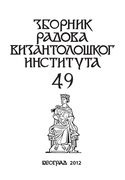Savladari: Konstantin i Licinije i podela Balkanskog poluostrva
Co-regency: Constantine and Licinivs and the political division of the Balkans
Author(s): Miroslava MirkovićSubject(s): History
Published by: Vizantološki institut SANU
Keywords: co-regency; Constantine; Licinius; battle of Cibalae; Licinius’ decennalia; silver plates from Naissus; territorial division between Augusti and Caesares
Summary/Abstract: In the agreement which followed the first war between Constantine and Licinius and Constantine’s victory on the Campus Ardiensis, Licinius was forced, as generally accepted, to surrender Illyricum where he was undisputed ruler until 316. However he was not neutralized politically and reigned together with Constantine between AD 316 and 324. Some kind of division of the sphere of interest seems to have existed between them. Constantine, whose movements in the Balkans are known from the places of editing laws, visited only the western half, i.e. Illyricum after 316. If we follow the evidence of the places and dates of the promulgation of Constantine’s laws, we can consider the line dividing the region controlled by Constantine and that under Licinius’ command, running from the North to the South and leaving Constantine the Pannonian provinces, Moesia I, Dacia Ripensis, Dacia Mediterranea and Dardania, as well as Macedonia, with the legionary camps on the Danube in Pannonia and Moesia I; the provinces on the East of that line, Moesia II, Scythia Minor and Thracia belonged to the region in which Licinius had command. However, there is evidence indicating that the territorial division of the Balkans between Constantine and Licinius after the battle of Cibalae was not strictly observed except on the Danube, in the zone where the military camps were located. In spite of Constantine’s presence in Illyricum, Licinius’s influence on the high commanders on the Danube never disappeared nor did his presence in the provinces he lost after the Bellum Cibalense. Licinius had the jubilee silver plates made for hisdecennaliain Naissus in Dacia Mediterranea. The siver plates which have been produced in Naissus, in the part of the Balkans which was under Constantine’s control, bear the inscription LICINI AVGVSTE SEMPER VINCAS. The co-operation between Constantine and Licinius concerned the defense of the frontiers and the administration in both parts of the Empire, but it was not based on the subordination of one to another as it was in the time of Diocletian who created the system tetrarchy.
Journal: Зборник радова Византолошког института
- Issue Year: 2012
- Issue No: 49
- Page Range: 7-18
- Page Count: 12
- Language: English

